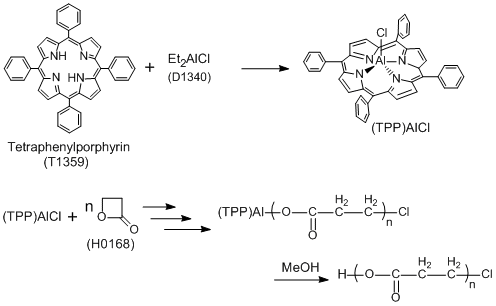Published TCIMAIL newest issue No.197
Maximum quantity allowed is 999
Bitte wählen Sie die Menge aus.
CAS RN: 917-23-7 | Produkte #: T1359
Tetraphenylporphyrin (Chlorin free)

Reinheit: >98.0%(HPLC)
Synonyme
- Tetraphenylporphine (Chlorin free)
- TPP (Chlorin free)
Produktdokumente:
| Einheit | Stückpreis | Belgien | Japan* | Menge |
|---|---|---|---|---|
| 1G |
€132.00
|
12 | ≥40 |
|
*In Belgien verfügbare Lagerbestände werden in 1 bis 3 Tagen geliefert.
*In Japan verfügbare Lagerbestände werden in 1 bis 2 Wochen geliefert. (unter Ausschluss von regulierten Artikeln und Trockeneislieferungen).
| Artikel # | T1359 |
| Reinheit / Analysenmethode | >98.0%(HPLC) |
| Summenformel / Molekülmasse | C__4__4H__3__0N__4 = 614.75 |
| Physikalischer Zustand (20 °C) | Solid |
| Lagerungstemperatur | Room Temperature (Recommended in a cool and dark place, <15°C) |
| Unter Inertgas lagern | Store under inert gas |
| Zu vermeidende Bedingungen | Air Sensitive |
| Verpackung und Behälter | 1G-Glass Bottle with Plastic Insert (Bild ansehen) |
| CAS RN | 917-23-7 |
| Reaxys Registrierungsnummer | 379542 |
| PubChem-Stoff-ID | 87577126 |
| MDL-Nummer | MFCD00011680 |
Spezifikation
| Appearance | Orange to Brown to Dark purple powder to crystal |
| Purity(HPLC) | min. 98.0 area% |
| Tetraphenylchlorin | max. 0.5 % |
| NMR | confirm to structure |
Eigenschaften
GHS
Verwandte Gesetze:
| EC-Nummern | 213-025-9 |
Transportinformationen:
| HS-Nr. (Import / Export) (TCI-E) | 2933998090 |
Anwendung
Molecular-weight Controlled Polymerization Using Aluminum-porphyrins

Typical Procedure:
The flask containing tetraphenylporphine ((TPP)H2)(1.0 mmol) is purged with dry N2, and then CH2Cl2 (20 mL) is introduced to dissolve (TPP)H2. To this solution is added Et2AlCl (1.2 mmol, 20% excess to (TPP)H2) by syringe under a N2 atmosphere at room temperature with stirring. After a definite time, the volatile materials are removed from this reaction mixture under reduced pressure to give a purple solid (TPP)AlCl) with metallic luster. CH2Cl2 (20 mL) is introduced to this flask to dissolve the product, to obtain the catalyst solution.
To the catalyst solution ((TPP)AlCl 20.4 mM) with stirring is added β-propiolactone (6.12 mol) by syringe at room temperature in a N2 atmosphere. After a definite time, a large excess of methanol is added to the reaction mixture to stop the polymerization, and then volatile materials are removed under reduced pressure to leave the product. The polymer is isolated as a slightly yellow-green powder by precipitation of the product from chloroform/methanol after shaking the chloroform solution with dilute hydrochloric acid.
The gel permeation chromatogram (GPC) of the resulting polymer shows the weight average molecular weight to the number average molecular weight (Mw/Mn) : 1.26 and the number average molecular weight (Mn) : 3500.
The flask containing tetraphenylporphine ((TPP)H2)(1.0 mmol) is purged with dry N2, and then CH2Cl2 (20 mL) is introduced to dissolve (TPP)H2. To this solution is added Et2AlCl (1.2 mmol, 20% excess to (TPP)H2) by syringe under a N2 atmosphere at room temperature with stirring. After a definite time, the volatile materials are removed from this reaction mixture under reduced pressure to give a purple solid (TPP)AlCl) with metallic luster. CH2Cl2 (20 mL) is introduced to this flask to dissolve the product, to obtain the catalyst solution.
To the catalyst solution ((TPP)AlCl 20.4 mM) with stirring is added β-propiolactone (6.12 mol) by syringe at room temperature in a N2 atmosphere. After a definite time, a large excess of methanol is added to the reaction mixture to stop the polymerization, and then volatile materials are removed under reduced pressure to leave the product. The polymer is isolated as a slightly yellow-green powder by precipitation of the product from chloroform/methanol after shaking the chloroform solution with dilute hydrochloric acid.
The gel permeation chromatogram (GPC) of the resulting polymer shows the weight average molecular weight to the number average molecular weight (Mw/Mn) : 1.26 and the number average molecular weight (Mn) : 3500.
References
- T. Aida, R. Mizuta, Y. Yoshida, S. Inoue, Makromol. Chem. 1981, 182, 1073.

- T. Yasuda, T. Aida, S. Inoue, Macromolecules 1984, 17, 2217.

- S. Asano, T. Aida, S. Inoue, J. Chem. Soc. Chem. Commun. 1985, 1148.

- Y. Watanabe, T. Yasuda, T. Aida, S. Inoue, Macromolecules 1992, 25, 1396.

- M. Komatsu, T Aida, S. Inoue, J. Am. Chem. Soc. 1991, 113, 8492.

- H. Sugimoto, M. Kuroki, T.Watanabe, C. Kawamura, T. Aida, S. Inoue, Macromolecules 1993, 26, 3403.

PubMed Literatur
Artikel / Broschüren
Produktdokumente (Hinweis: Für einige Produkte sind keine Analysediagramme verfügbar.)
Sicherheitsdatenblatt (SDB)
Bitte wählen Sie Sprache.
Das angeforderte SDB ist nicht verfügbar.
Bitte Kontaktieren Sie uns für mehr Informationen.
Spezifikationsdokumenten
AZ & andere Zertifikate
Bitte geben Sie die Lotnummer ein
Falsche Chargennummer wurde eingegeben. Bitte geben Sie nur 4-5 alphanumerische Zeichen vor dem Bindestrich ein.
Muster-AZ
Dies ist ein Muster-AZ und repräsentiert möglicherweise nicht eine kürzlich hergestellte Charge des Produkts.
Ein Muster-AZ für dieses Produkt ist zur Zeit nicht verfügbar.
Analytische Diagramme
Bitte geben Sie die Lotnummer ein
Falsche Chargennummer wurde eingegeben. Bitte geben Sie nur 4-5 alphanumerische Zeichen vor dem Bindestrich ein.
Das angeforderte Analysediagramm ist nicht verfügbar. Wir entschuldigen uns für die Unannehmlichkeiten.






![TPP (=Tetraphenylporphyrin) [Ultra-high sensitive spectrophotometric reagent for Cu] TPP (=Tetraphenylporphyrin) [Ultra-high sensitive spectrophotometric reagent for Cu]](/medias/A5012.jpg?context=bWFzdGVyfHJvb3R8NDUyNTN8aW1hZ2UvanBlZ3xhREJtTDJoaU1DODRPVEk0TlRFeU1UZ3dNalUwTDBFMU1ERXlMbXB3Wnd8MmU4MjU4OThkYTY4ODU5YzFjZmE4YTBjMjQ3NjkwM2UxYTNmNTllN2RkMzMyZDFkODJjOGY3ZTQwZmFhNjk1OA)